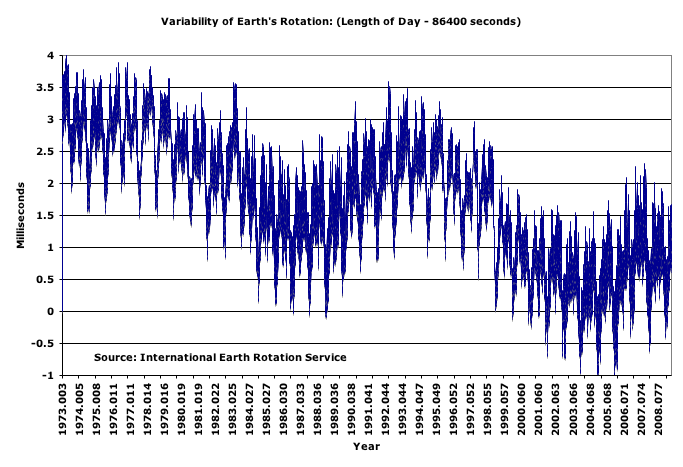Every day of every year nominally lasts 24 hours, or 1,440 minutes, or 86,400 seconds. This December 31st, as happens on irregular occasions, will actually last 86,401 seconds. You are of course familiar with leap days, which occur on leap years, which occur every four years, except on century boundaries unless the century boundary happens to be divisible by 400 (as was the case in 2000).
Leap seconds are not so easy to predict. They are based on irregularities in the Earth’s rotation, as measured by the International Earth Rotation Service, and can happen on either June 30 or December 31. When it happens, there is an official time that is December 31, 23:59:60. UTC is adjusted accordingly, which is what just about all local time is derived from.
As it turns out, we haven’t seen leap second in a while, and here is why:
This information shows deviation from 86,400 seconds in terms of the average time it took for Earth to rotate once for each day of the year. Since 1997, the world has actually slowed down, although there’s been a slight pickup in pace over the last two years.
How do we know that the Earth slowed down? You might think that the definition of time is based on the Earth’s rotation and its orbit around the sun, but in fact that definition is somewhere between disputed and obsolete. The actual definition is as follows:
the duration of 9,192,631,770 periods of the radiation corresponding to the transition between the two hyperfine levels of the ground state of the cesium 133 atom.
If we now take that really large number of periods, using a Cesium clock, we can mulitply it by the number of seconds in a day and compare against where we think the Earth should be. If it hasn’t quite gotten all the way around, then we note the difference, and add that to a cummulative difference. Eventually it is necessary to hold up clocks by a second to let the Earth catch up.
